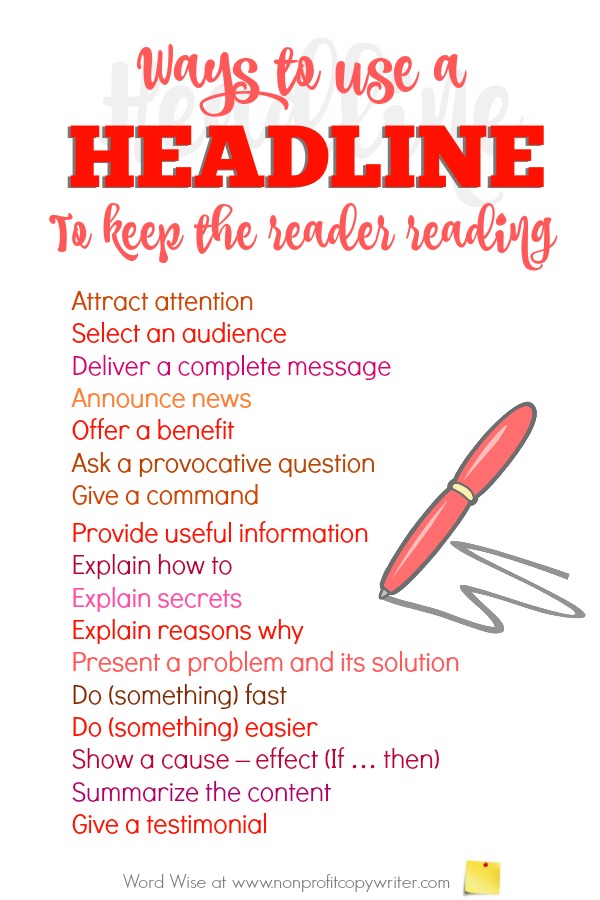
Basics for Copywriting Headlines
Award-winning writer Kathy Widenhouse has helped hundreds of nonprofits and writers produce successful content and has gained 600K+ views for her writing tutorials. She is the author of 9 books. See more of Kathy’s content here.
Updated 7.1.24
While every writing task is important, copywriting headlines is crucial. A headline is your introduction, first impression, opening line, and sales pitch all rolled into one.
That’s plenty intimidating. But never fear! Here you’ll find plenty of practical information to help you learn to write compelling headlines including …
- how headlines work to impact the reader
- headline mechanics
- kinds of headlines and headline formulas
Copywriting headlines – and doing it well – simply takes a bit of common sense and a decent amount of practice. But first things first.
Q. What is a headline?
A headline is text that introduces the subject matter of the piece. It can take different forms. A headline is known as a title (above an article), a subject line (for an e-mail), a banner (on a newsletter), teaser (on an outer envelope), a Johnson box (on a direct mail letter), or even a caption (below a photo).
Q. Why are headlines so important?
Eight out of 10 people read headlines. Just 2 out of 10 read the rest of the piece. Those who actually read your headline will decide within an estimated 5 – 10 seconds whether or not to continue. The headline is the first entry point to your article, web page, or email campaign. If the reader stops at the headline, your piece will not get read. That’s why the headline plays an especially crucial role in any piece.
Q. What does a headline do?
Every element of a compelling piece has just one purpose – to get the next sentence read, culminating in the call to action. (Obviously, the call to action’s job is to get the reader to take a specific action.)
It follows then that headline’s singular most important function is to draw the reader into the piece and keep reading.
Q. What are some ways a headline can convince my reader to keep reading?
These methods are the most commonly used by writers use to create engaging headlines.
- Attract attention
- Select an audience
- Deliver a complete message
- Announce news
- Offer a benefit
- Ask a provocative question
- Give a command
- Provide useful information
- Explain how to
- Explain secrets
- Explain reasons why
- Present a problem and its solution
- Do (something) fast
- Do (something) easier
- Show a cause – effect (If … then)
- Summarize the content
- Give a testimonial
Q. Should I capitalize the headline?
The first word in a headline is always capitalized. Beyond that, follow the writer’s guidelines for the specific publication or client.
Q. How long should a headline be?
That depends.
- Article headlines are typically short – 3-6 words or less.
- Email subject lines vary in their optimal length between 27 to 77 characters depending on which kind of device is used to view them, but those subject lines with 35 characters or less get the best open rates.
- Web page meta titles – the text that appears on the browser header – should be 90 – 150 characters. (Various browsers allow different lengths.)
- Facebook post titles with 90 characters or less receive the highest number of shares.
Special tips:
- Copywriter Ted Nicholas (Mr. 17-Times-The-Sales) asserts that a headline should never be longer than 17 words.
- Marketing guru Dan Kennedy endorses long headlines for long direct response copy.
Bottom line: headline length is closely associated with the type of piece for which it’s written. A headline should be as long as it needs to be to get the specific job done.
Q. Should I write the headline before or after the rest of the piece?
Some writers swear that writing the headline first keeps the main idea of the piece front and center and allows them to stay on task. Others write their piece first and later summarize it with the headline. Still others write out the piece’s main idea, write the piece, and then decide if the main idea serves as the headline. Try each approach to copywriting headlines and go with what works for you.
More Tips for Writing Headlines
Writing Better Headlines: Simple As 3 + 3 ...
Write Great Headlines With One Simple Formula ...
How to Write How-To Headlines That Pull in More Readers ...
When Do Question Headlines Work?
Top 12 Headline Templates and Why They Work ...
The Problem with Clickbait Headlines (and how to solve it) ...
7 Tips for Using Numbers in Headlines ...
Write a Better Headline When You Answer One Simple Question ...
The 9 Most Surprising Places You Need a Powerful Headline ...
Top copywriting headlines tips: getting started, headline mechanics ...
10 words to use when writing headlines ...
Does your headline do its job?
5-point checklist to use when you write a headline ...
The SELWAB Formula: great for writing leads and headlines ...
Try these 5 proven headline formulas ...
How to Redeem a Bad Headline (So Readers Keep Reading) ...
6 secrets of effective subheads ...
The 4 U's: use this checklist for writing powerful headlines ...
See more tips on our Writing Headlines Pinterest board...
Return from Basics about Copywriting Headlines
to Nonprofit Copywriter home
As an Amazon Associate I earn from qualifying purchases.
Search This Site
Share This Page

Named to 2022 Writer's Digest list
BEST GENRE/NICHE WRITING WEBSITE


Stop Wasting Time!

Grab your exclusive FREE guide, "5 Simple Writing Tips You Can Put to Use in 10 Minutes or Less"









